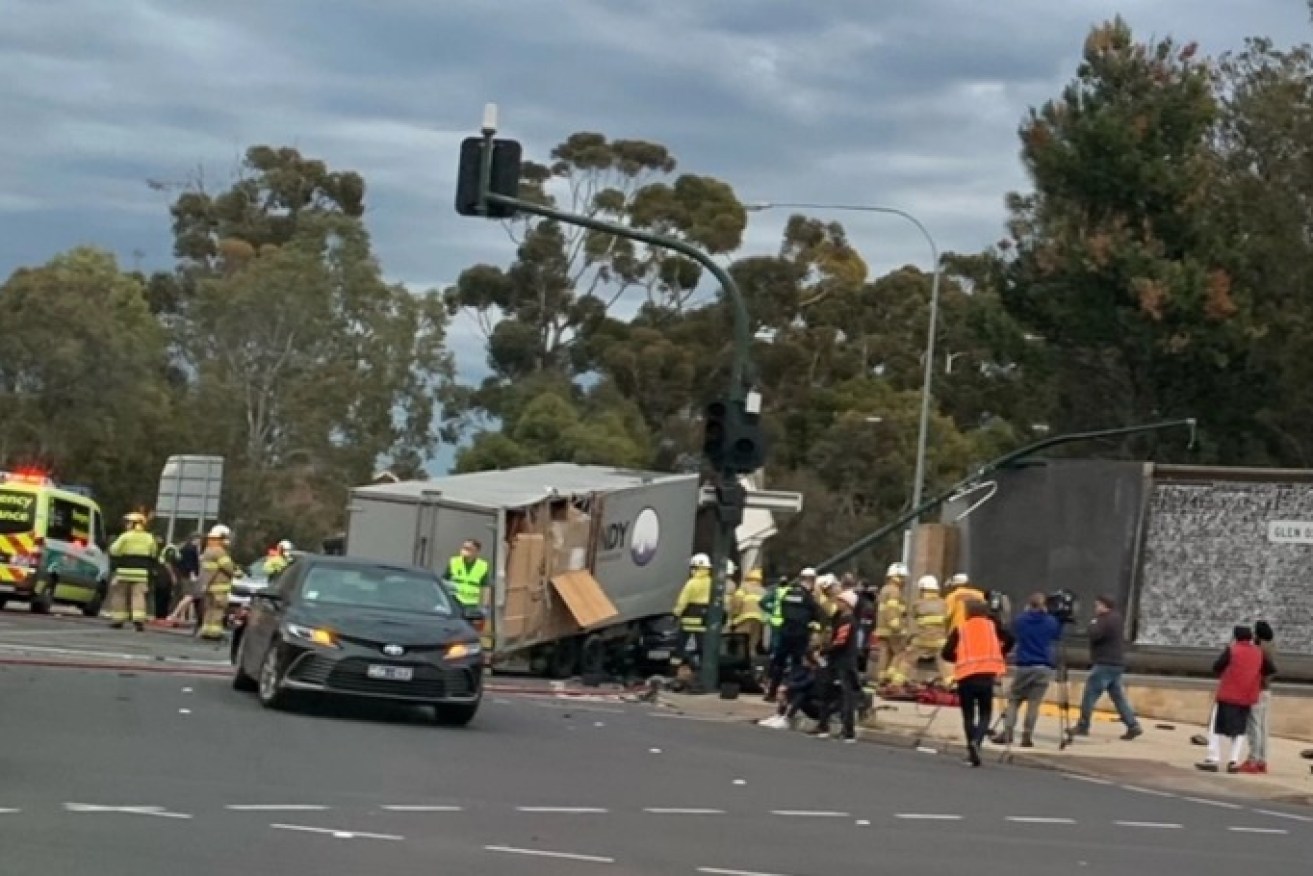No quick freeway safety fix after latest truck crash
The state government will focus on driver education and training and consider better signage and a slower lane at Crafers to improve safety on the South Eastern Freeway downtrack, while “long term” options such as a third arrester bed will need “more investigation to ensure they are feasible”.


The scene at the bottom of the freeway after a truck crash which injured nine people on Sunday, July 24. Photo: Rebekah Clarkson
Infrastructure and Transport Minister Tom Koutsantonis today announced 16 proposals to improve heavy vehicle safety on the freeway downtrack, following months of consultation with industry.
Freeway safety was put under the spotlight after another truck accident in July when an out of control truck ploughed through seven cars and a bus at the end of the freeway, injuring nine people at the Portrush and Glen Osmond Road intersection.
The truck driver from Queensland was later arrested and charged with a number of offences including driving unlicensed.
The Department of Infrastructure and Transport has since been reviewing heavy vehicle safety on the freeway and has held three industry roundtables to discuss the issue.
The government’s shortlisted freeway safety proposals, released today, are categorised as “short”, “medium” and “long term” options.
The majority of the options are categorised as short-term, with the list including “education and awareness” campaigns, “improvements” to licensing and driver training, and “work(ing)” with the National Heavy Vehicle Regulator to send “education material to fleet operators”.
Other short-term options include “continu(ing) to investigate enhanced communication to drivers/vehicles”, revising on-road freeway signage, and introducing a slower zone at the top of the hill at Crafers to “enable low gear engagement by trucks”.
The four long-term options are building a third arrester bed, widening road shoulders for emergency stopping, making “improvements” to national licensing and driver training, and undertaking a “further investigation study” for a targeted stopping station for heavy vehicle inspection.
Koutsantonis said the short-term options “could be delivered within months” but the longer-term options “will require more investigation to ensure they are feasible”.
“The state government will now consider all of these short, medium and long-term options before deciding which will proceed,” he said in a media release today.
“This is a complex challenge and there is no single solution that will prevent all incidents from happening on all occasions.”

The 16 shortlisted safety proposals released by the state government today.
Koutsantonis said this morning that fixing the Portrush/Glen Osmond Road intersection “will take a long-term solution”.
“We’re trying to retrofit procedures in place to make it work, quite frankly it’s going to be expensive. It’s going to take a long period of time,” he said.
“The government doesn’t have all the answers here: we’ve been talking to road traffic experts, the National Heavy Vehicle Regulator, the users, the freight industry, livestock people, to local residents and councils.”
Koutsantonis said he wanted to point out that “overwhelmingly, every truck driver who’s using this road behind us knows exactly how to deal with the decline”.
“We are talking about .0001 per cent of drivers who potentially make an error here at the very beginning and then are trying to save the truck.
“But overwhelmingly, those who do lose control know they can use the first and second arrestor beds.
“The question for us is: why is it that when there’s a truck out of control at the bottom of the hill, people have avoided the first and second arrestor beds.”
The state government in October ruled out an earlier proposal to reduce heavy vehicle speeds from 60km/h to 40km/h, citing departmental modelling that doing so would “create additional safety risks”.
Today’s list of shortlisted proposal does however include a “medium-term” option of creating a 40km/h slow checking zone for heavy vehicles below the Mount Osmond interchange.
The state government last week held the last of its three industry roundtables on freeway safety, which received “hundreds of suggestions”.
The roundtables were held with interest groups including the RAA, the Australian Trucking Association, the SA Road Transport Association, the SA Freight Council and SA Police.
Koutsantonis said “we’ve had nothing brought off the table” following the industry roundtables.
“The government’s considering every single option put to us, and I think we’ve got a good suite of packages here for us to consider.”




